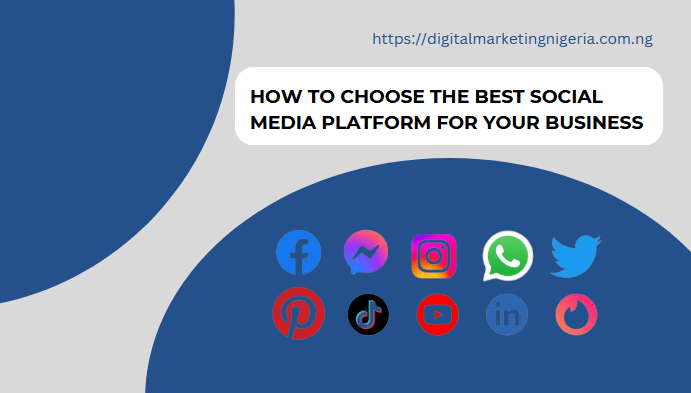It is no longer news that business owners are readily taking advantages of social media platforms to promote their businesses, generate leads and boost sales; you should also do same, but you need to know how to choose the right social media platform to promote your business.
Marketing has moved beyond traditional methods and is now concerned with storytelling. You place ads to sell your products. In this article, we shall be exploring in details, 8 major steps to choosing a social media platform that is suitable for your business.
You will agree that buying on social media is a task that cannot be ignored. Social media platforms are the only place where you can tell your story to millions of people.
Once you have decided to invest in social media marketing, the next step is to decide which social media platform you should focus on. This is important, and in this article we describe the conditions you need to consider before taking action.
Each social media platforms have their own characteristics and limitations, and you should focus on making the most of what each platform has to offer.
1. Identify Your Target Audience
You need to understand your business’ target audience because this can help you better connect with your customers while meeting their needs. A target audience is a group of specific customers (those most likely to engage with your product or service). , create audience profiles and assist on social media.
2. Locate where your target audience are
Once you determine who your target audience is, the next step is to find out where they visit online, when they visit platforms, and what they do on platforms. You should create a strategy to meet the platforms they hang out on. Please understand that each social media platform is unique to its users.
Another important thing to remember here is that people on LinkedIn react differently to certain messages than audiences on Facebook or TikTok.
3. Identify the content-type that works on each social media platform
To create content for marketing campaigns, you need to understand what content works on different platforms. For other social media platforms. Trading of shoes, bags, perfumes, clothes and glasses and financial institutions. There are many types of this business such as B2C and B2B.
That’s why they take advantage of social media platforms such as Facebook, Instagram, Pinterest and TikTok. The type of advertising required for this type of business would be products and quotes. The best platform for networking is LinkedIn.
You can find professionals from all walks of life on LinkedIn. Companies also use the platform on a B2B basis. It’s important to choose the platform that best suits the type of content your business provides.
4. Find out which social media platform suits your business
Be reminded that most social media platforms today are dedicated to integrating live streaming, augmented reality, shopping, social media, etc. This is important when choosing the social media platform you want to use for your business.
Yes, your address is important when choosing which platform to use. From the Wearesocial report, as shown below, you will see that Whatsapp, Facebook, YouTube, Instagram, Messenger, twitter, telegram, LinkedIn, TikTok, Snapchat, Pinterest and Skype, among other influences, are the platforms used more.
Having trouble choosing which social media network to use? We are here for you. Send us a short message and we’ll schedule a meeting with you and your team.
Having trouble choosing which social media network to use? We are here for you. Send us a short message; let’s schedule a meeting with you (your team). We are just a phone call/chat away.
5. Ensure your chosen platforms supports auto sharing
You can use social media to drive traffic to your website or blog. You may need to post the video on YouTube and share it on IGTV. You can share blog/website content on LinkedIn. Meet different audiences: different platforms.
Some platforms also allow you to share your platform with other platforms. For example, you can share posts on Instagram and then share them on Facebook and Twitter. Be Fair
6. Be consistent and honest
If you want to achieve your goals, you must be consistent and honest. If you post regularly, you’ll get better results than someone who posts once a month or quarterly. Social media is the foundation of any social media site.
7. Consider customer demographics
How do you know your customers? Are they older, younger, male or female? Start by doing some research on this topic. Once you dig into the publicly available information, you can narrow down the platform and find those with the best value.
Whichever you choose, invest some time and effort. Don’t scatter your efforts by trying to manage multiple platforms at the same time.
8. Consider your company
Your products and services, your personal goals, your business type… all influence your listing options. Highly visible brands like graphic designers and artists should explore platforms like DeviantArt, Dayflash, and Instagram, while large B2B businesses should make LinkedIn a priority.
Many large companies have great brands that do well on Instagram, like Apple. Likewise, creative work is still a job and they can benefit from what LinkedIn has to offer.
Some pipelines have broad appeal, like Instagram, while others, like DeviantArt, are more specific. You just need to evaluate what is right for your business and understand what your company does in relation to the options available to you.
In conclusion
It is highly recommended that you maintain only the number social media platforms you can manage and distribute effectively, rather than using them all aimlessly.
Instead of running a campaign on every platform that may or may not be suitable for your site, you can monitor, track and achieve your social media marketing goals by choosing the best platform for you.

